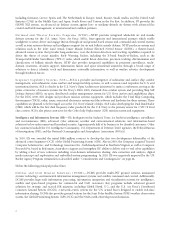Raytheon 2010 Annual Report Download - page 18
Download and view the complete annual report
Please find page 18 of the 2010 Raytheon annual report below. You can navigate through the pages in the report by either clicking on the pages listed below, or by using the keyword search tool below to find specific information within the annual report.specific to our industry. These risks include: the cost of obtaining and retaining trained and skilled employees; the
uncertainty and instability of prices for raw materials and supplies; the problems associated with advanced designs, which
may result in unforeseen technological difficulties and cost overruns; and the intense competition and the constant
necessity for improvement in facilities and personnel training. Our sales to the U.S. Government may be affected by
changes in procurement policies, budget considerations, changing concepts of national defense, political developments
abroad and other factors. See Item 1A “Risk Factors” and “Overview” within Item 7 of this Form 10-K for a more
detailed discussion of these and other related risks.
We are also involved in U.S. Government programs, principally through our IIS and SAS business segments, which are
classified by the U.S. Government and cannot be specifically described in this Form 10-K. The operating results of these
classified programs are included in our consolidated financial statements. The business risks and considerations
associated with these and our international classified programs generally do not differ materially from those of our other
programs and products. Total classified sales were 14%, 13% and 12% of total net sales in 2010, 2009 and 2008,
respectively.
We are subject to government regulations and contract requirements which may differ from U.S. Government regulation
with respect to our sales to non-U.S. customers. See “International Sales” below for more information regarding our sales
outside of the U.S. and Item 1A “Risk Factors” for a discussion of the risks associated with international sales.
See “Sales to the U.S. Government” on page 8 of this Form 10-K for information regarding the percentage of our
revenues generated from sales to the U.S. Government.
International Sales
Our sales to customers outside the U.S. were $5.8 billion or 23% of total net sales in 2010, $5.3 billion or 21% of total net
sales in 2009, and $4.6 billion or 20% of total net sales in 2008. In 2010, international sales were negatively impacted by
the UK Border Agency Program termination as described in “Commitments and Contingencies” on page 64. Included in
sales to customers outside the U.S. were foreign military sales through the U.S. Government of $3.3 billion, $2.8 billion
and $1.8 billion, in 2010, 2009 and 2008, respectively. International sales were principally in the fields of air defense
systems, missile systems, airborne radars, naval systems, air traffic control systems, missile defense systems, electronic
equipment, computer software and systems, homeland security solutions, personnel training, equipment maintenance
and microwave communication and other products and services permitted under the International Traffic in Arms
Regulations (ITAR). Generally, we finance our foreign subsidiary working capital requirements in the applicable
countries. Sales and income from international operations and investments are subject to U.S. Government laws,
regulations and policies, including the ITAR and the Foreign Corrupt Practices Act and the export laws and regulations
described below, as well as foreign government laws, regulations and procurement policies and practices, which may
differ from U.S. Government regulation, including import-export control, investments, exchange controls, repatriation
of earnings and requirements to expend a portion of program funds in-country. In addition, embargoes, international
hostilities and changes in currency values can also impact our international sales. Exchange restrictions imposed by
various countries could restrict the transfer of funds between countries and between Raytheon and its subsidiaries. We
have acted to protect ourselves against most undue risks through insurance, foreign exchange contracts, contract
provisions, government guarantees and/or progress payments. See revenues derived from external customers and long-
lived assets by geographical area set forth in “Note 16: Business Segment Reporting” within Item 8 of this Form 10-K.
In connection with certain foreign sales, we utilize the services of sales representatives who are paid commissions in
return for services rendered.
The export from the U.S. of many of our products may require the issuance of a license by either the U.S. Department of
State under the Arms Export Control Act of 1976 (formerly the Foreign Military Sales Act) and its implementing
regulations under the ITAR, the U.S. Department of Commerce under the Export Administration Act and its
implementing regulations as kept in force by the International Emergency Economic Powers Act of 1977 (IEEPA), and/or
the U.S. Department of the Treasury under IEEPA or the Trading with the Enemy Act of 1917. Such licenses may be
denied for reasons of U.S. national security or foreign policy. In the case of certain exports of defense equipment and
services, the Department of State must notify Congress at least 15-60 days (depending on the identity of the importing
country that will utilize the equipment and services) prior to authorizing such exports. During that time, Congress may
take action to block or delay a proposed export by joint resolution which is subject to Presidential veto.
10
























